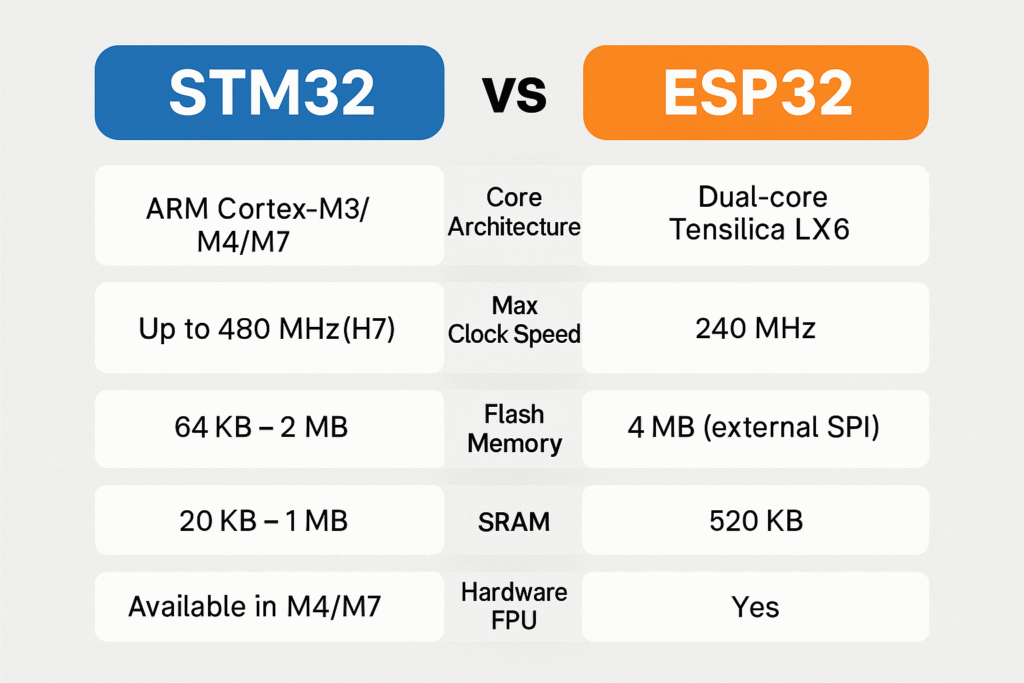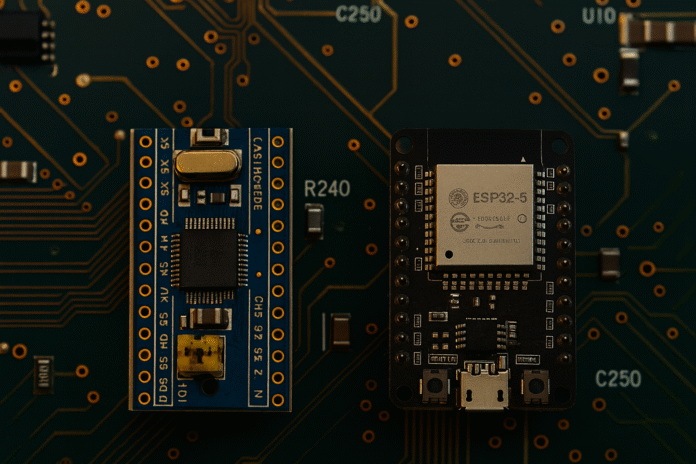In the field of embedded systems and PCB design, choosing the right microcontroller or SoC (System on Chip) can significantly impact your project’s success. Two of the most widely used options today are STM32 and ESP32. These devices serve various purposes in hardware development, offering distinct capabilities and ecosystems. Whether you’re building an IoT solution, industrial controller, wearable device, or automation system, understanding what sets them apart is vital.
This article thoroughly analyzes what is the difference between STM32 and ESP32. We will also explore their pros and cons, use cases, development environments, hardware capabilities, and more—helping you make an informed decision for your next pcb design project.
STM32 Overview
STM32 is a family of 32-bit microcontrollers based on the ARM Cortex-M cores, developed by STMicroelectronics. The STM32 series includes low-power models like STM32L, performance models such as STM32F4 and STM32F7, and high-speed variants like STM32H7.
Key Features:
- Based on ARM Cortex-M0/M3/M4/M7 cores
- Wide range of performance levels and power consumption profiles
- Extensive GPIO support
- Rich set of peripherals (ADC, DAC, USART, SPI, CAN, etc.)
- Long-term availability and industrial reliability
- Supported by STM32CubeIDE, STM32CubeMX, Keil, IAR
ESP32 Overview
ESP32 is a low-cost, low-power SoC developed by Espressif Systems. It includes dual-core Tensilica LX6 microprocessors and integrated Wi-Fi and Bluetooth capabilities, making it ideal for IoT and wireless communication applications.
Key Features:
- Dual-core 32-bit Tensilica LX6 CPUs (240 MHz)
- Integrated Wi-Fi and Bluetooth (Classic + BLE)
- Ultra-low-power modes
- Numerous GPIOs, ADC, DAC, SPI, I2C, UART
- Developed with the ESP-IDF (Espressif IoT Development Framework)
- Compatible with Arduino IDE and MicroPython
Which is Better: STM32 or ESP32?
Choosing between STM32 and ESP32 depends on your application needs.
STM32 is better for:
- Applications requiring real-time precision
- Automotive or medical device controllers
- Projects with strict power management needs
- Industrial-grade robustness and reliability
- Long-term production with traceable lifecycle
ESP32 is better for:
- IoT and wireless communication projects
- Rapid prototyping with wireless connectivity
- Low-cost, mass-market products
- DIY, hobbyist, and maker environments
- Projects requiring Bluetooth, BLE, or Wi-Fi by default
While STM32 offers industrial-level robustness and a broad range of hardware choices, ESP32 provides greater out-of-the-box functionality with wireless communication and a user-friendly ecosystem.

What Are the Disadvantages of STM32?
Despite its strengths, STM32 comes with a few challenges:
Steep Learning Curve: Tools like STM32CubeIDE and CubeMX require significant time to learn, especially for beginners.
No Built-In Wireless: STM32 does not include Wi-Fi or Bluetooth natively. You need external modules like ESP8266 or BLE modules.
Cost for Peripherals: Integrating connectivity or high-level interfaces may increase BOM costs.
Firmware Development Overhead: Complex configuration and hardware abstraction layers require a deeper understanding of embedded programming.
What Are the Disadvantages of ESP32?
ESP32, while versatile and affordable, also has its limitations:
Less Deterministic: Due to its FreeRTOS-based scheduling, timing precision is not as strict as STM32.
Limited Industrial Certifications: ESP32 is not always preferred in regulated industries (automotive, aerospace, medical).
Reduced ADC Accuracy: Many developers note poor analog-to-digital conversion performance.
Shorter Lifecycle Support: Newer variants of ESP chips are frequently released, but long-term availability may not be guaranteed.
What is the Difference Between STM32 BluePill and ESP32?
STM32 BluePill is a compact and affordable STM32F103C8T6-based development board, often used in education and prototyping. It features:
- 72 MHz ARM Cortex-M3 core
- 64KB Flash, 20KB SRAM
- USB and serial debug support
- No native wireless connectivity
By comparison, ESP32 DevKit includes:
- 240 MHz dual-core LX6 CPU
- 4 MB Flash (typically)
- Wi-Fi and Bluetooth BLE
- USB to UART bridge for programming
In short: STM32 BluePill is ideal for learning low-level microcontroller programming and real-time applications, while ESP32 is better suited for projects needing wireless communication and faster processing.
What is STM32 Good For?
STM32 microcontrollers excel in scenarios where timing precision, power efficiency, and long-term stability are priorities. Key areas include:
Medical devices (ECG monitors, infusion pumps)
Industrial controls (PLCs, robotic arms)
Automotive systems (engine controllers, CAN nodes)
Wearable devices with custom power profiles
Safety-critical systems with real-time constraints
STM32 also supports TrustZone, memory protection units (MPU), and fault-handling features for mission-critical operations.
Is STM32 Beginner Friendly?
STM32 is not typically beginner friendly due to:
A steeper configuration process
More complex IDEs (CubeIDE, Keil)
Requirement for deeper C/C++ embedded knowledge
Peripheral initialization requiring HAL/LL understanding
However, STM32 provides vast documentation, online resources, and community support. Once mastered, the platform offers great flexibility and control.
What is ESP32 Good For?
ESP32 stands out in wireless and battery-powered applications. Key uses include:
Smart home devices (switches, lights, thermostats)
IoT sensors and nodes
Remote data loggers
Wearables with BLE connectivity
Robotics with app-control features
Audio applications (internet radios, Bluetooth speakers)
With MicroPython and Arduino IDE support, ESP32 offers a smooth entry point for hobbyists and non-experts.
Development Ecosystems: STM32 vs ESP32
STM32:
- STM32CubeIDE (Eclipse-based)
- STM32CubeMX for graphical configuration
- ARM Keil MDK and IAR Embedded Workbench support
- CMSIS libraries and HAL/LL drivers
- Debug with ST-Link or J-Link
ESP32:
- ESP-IDF (CMake-based, official SDK)
- Arduino IDE support
- PlatformIO compatibility
- MicroPython and Lua support
- Debug with JTAG or serial output
STM32 IDEs are designed for industrial-grade software development with optimized performance. ESP32 tools are more accessible for quick development and community-driven projects.
Connectivity: ESP32 Wins
ESP32 has onboard Wi-Fi (802.11 b/g/n) and Bluetooth (Classic + BLE), making it unbeatable for connected systems. STM32 requires external modules like ESP8266, BLE nRF modules, or cellular modems for wireless features.
Processing Power and Memory
| Feature | STM32 (e.g., F4/F7/H7) | ESP32 |
|---|---|---|
| Core Architecture | ARM Cortex-M3/M4/M7 | Dual-core Tensilica LX6 |
| Max Clock Speed | Up to 480 MHz (H7) | 240 MHz |
| Flash Memory | 64 KB – 2 MB | 4 MB typical (external SPI) |
| SRAM | 20 KB – 1 MB | 520 KB |
| Hardware FPU | Available in M4/M7 | Yes |
Power Efficiency
STM32 excels in ultra-low power designs with STM32L0/L4/L5 series offering nanoamp sleep modes. ESP32 offers good low-power modes but consumes more in active states due to its dual-core setup.
For battery-powered projects requiring long life, STM32 usually provides better efficiency.
Security Features
STM32 supports:
- Secure Boot
- TrustZone
- Hardware cryptography
- Secure firmware update protocols
ESP32 includes:
- Secure boot
- Flash encryption
- HMAC, AES, SHA-2 hardware accelerators
Both platforms cater to security needs, but STM32 offers a wider range of secure MCUs with industrial certifications.
Which to Choose for Your Next Project?
| Requirement | Recommended Chip |
|---|---|
| Real-time industrial automation | STM32 |
| Medical-grade or safety systems | STM32 |
| Wi-Fi enabled smart home controller | ESP32 |
| Bluetooth low-energy beacon | ESP32 |
| Long-term industrial deployment | STM32 |
| Cost-effective consumer electronics | ESP32 |
| Educational robotics platform | ESP32 |
| Custom wearable with low power draw | STM32 |
Price and Availability
STM32 microcontrollers vary greatly in cost, depending on features and series. Entry-level BluePill clones are extremely cheap (around $2), while high-performance STM32H7 may cost over $10.
ESP32 boards like DevKitC or NodeMCU are typically priced between $3 and $7, including wireless capability, making them very cost-effective for wireless projects.
Community and Support
STM32: Strong support from ST, multiple forums, extensive datasheets, and industrial examples.
ESP32: Large maker and hobbyist community, examples on GitHub, excellent Arduino IDE support, countless tutorials.
Both chips have great support systems, but ESP32 wins for beginners due to its Arduino/MicroPython ecosystem.
Conclusion
The decision between STM32 and ESP32 largely depends on your project type, budget, power requirements, and the development environment you’re comfortable with. STM32 is best suited for high-performance, long-term, and mission-critical applications, while ESP32 dominates in wireless IoT and maker projects.
By understanding what is the difference between STM32 and ESP32, you can select the right platform that matches your design goals, whether you’re focused on robust industrial automation or quick-to-market smart devices.
